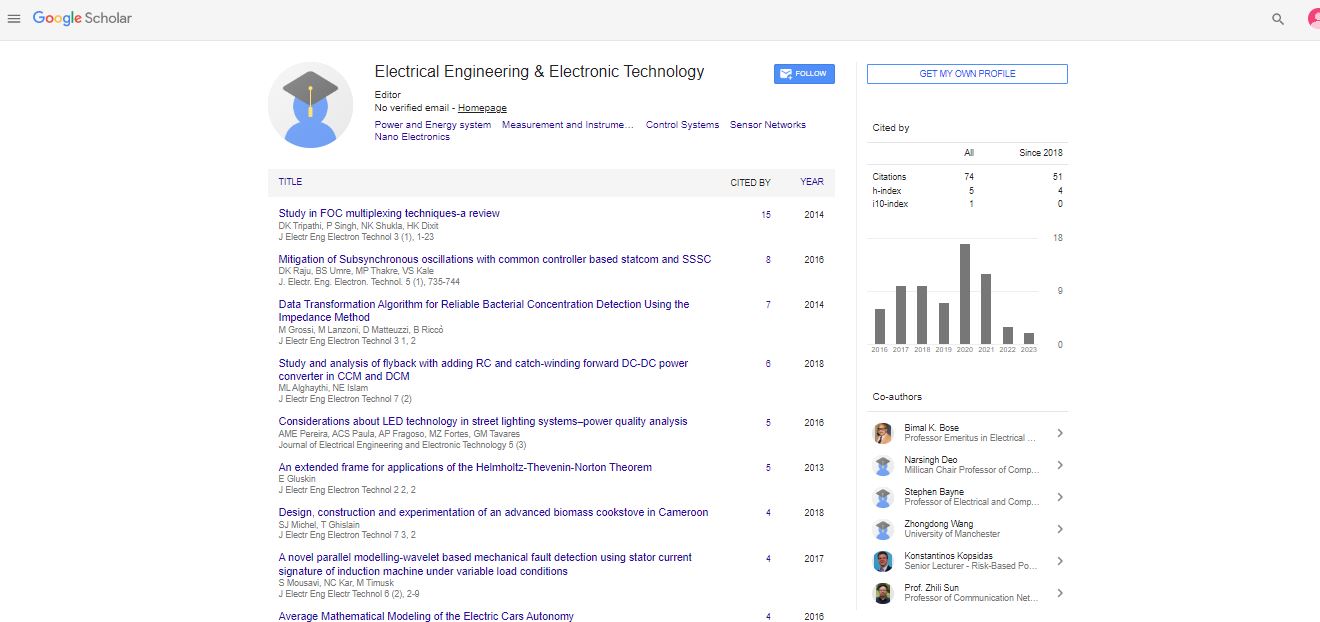Editorial, J Electr Eng Electron Technol Vol: 14 Issue: -2
Light Fidelity (Li-Fi): Illuminating the Future of Wireless Communication
Tanja Poulain*
Department of Microelectronics, Universidad de Concepción, Chile
- *Corresponding Author:
- Tanja Poulain
Department of Microelectronics, Universidad de Concepción, Chile
E-mail: tanja967@gmial.com
Received: 01-Mar-2025, Manuscript No. jeeet-25-170131; Editor assigned: 4-Mar-2025, Pre-QC No. jeeet-25-170131 (PQ); Reviewed: 18-Mar-2025, QC No. jeeet-25-170131; Revised: 25-Mar-2025, Manuscript No. jeeet-25-170131 (R); Published: 31-Mar-2025, DOI: 10.4172/2325-9838.10001002
Citation: Tanja P (2025) Light Fidelity (Li-Fi): Illuminating the Future of Wireless Communication. J Electr Eng Electron Technol 14: 1002
Introduction
In our increasingly connected world, the demand for faster, more secure, and more efficient wireless communication continues to grow. While Wi-Fi has been the dominant wireless technology for decades, it faces challenges such as limited bandwidth, congestion, and security vulnerabilities. Enter Light Fidelity (Li-Fi)â??a revolutionary wireless communication technology that uses light instead of radio waves to transmit data [1]. First introduced by Professor Harald Haas in 2011, Li-Fi offers a promising alternative that could redefine the way we connect to the internet and interact with smart devices [2].
Discussion
Li-Fi works by using visible light communication (VLC). Data is transmitted through light emitted by LEDs that flicker at extremely high speedsâ??so fast that the human eye cannot detect them. A photodetector receives these signals and converts them into data that devices can understand. This approach allows light to serve as a data transmission medium, similar to how fiber optics use light for high-speed internet but in a wireless form [3].
One of Li-Fiâ??s key advantages is its incredible speed. In lab conditions, Li-Fi has achieved data transfer rates exceeding 100 Gbps, far surpassing current Wi-Fi speeds. This makes it ideal for applications requiring ultra-high-speed internet, such as 4K/8K video streaming, real-time gaming, and industrial automation.
Another major benefit of Li-Fi is its security. Since light cannot penetrate walls, Li-Fi signals are confined to a specific room or area. This physical limitation drastically reduces the risk of unauthorized access and hacking, making it highly suitable for environments that require secure communications, such as military bases, hospitals, and financial institutions [4].
Li-Fi is also well-suited for environments where radio frequency (RF) signals are restricted or can interfere with sensitive equipmentâ??like hospitals, airplanes, and underground facilities. Because it uses the light spectrum, which is 10,000 times larger than the RF spectrum, Li-Fi also helps reduce network congestion in areas with many connected devices.
However, Li-Fi does face some limitations. Its dependency on line-of-sight communication means that it doesn't work through walls or obstructions. This could require multiple light sources and receivers throughout a building to maintain continuous connectivity. Also, since Li-Fi needs light to function, it is ineffective in complete darkness or when the lights are offâ??unless infrared light is used [5].
Despite these challenges, rapid advances in LED and photodetector technologies are making Li-Fi more practical and affordable. Companies and researchers worldwide are actively working on integrating Li-Fi into smartphones, laptops, streetlights, and even household lighting systems.
Conclusion
Li-Fi represents a transformative shift in wireless communication technology. By harnessing the power of light, it offers unprecedented speed, enhanced security, and reduced interferenceâ??making it a strong complement or even an alternative to Wi-Fi in certain environments. While it is still in the early stages of commercial deployment, ongoing innovation and increasing data demands suggest that Li-Fi has a bright future ahead. As smart cities, connected devices, and the Internet of Things (IoT) continue to grow, Li-Fi could soon become a cornerstone of our digital infrastructure.
References
- Hepler CD (1988) Unresolved issues in the future of pharmacy. Am J Hosp Pharm 45: 1071-1081.
- Glassman PM, Balthasar JP (2019) Physiologically-based modeling of monoclonal antibody pharmacokinetics in drug discovery and development. Drug Metab Pharmacokinet 34: 3-13.
- Wang Y, Zhu H, Madabushi R, Liu Q, Huang SM, et al. (2019) Modelâ?informed drug development: current US regulatory practice and future considerations. Clin Pharmacol Ther 105: 899-911.
- Daubner J, Arshaad MI, Henseler C, Hescheler J, Ehninger D, et al. (2021) Pharmacological neuroenhancement: current aspects of categorization epidemiology pharmacology drug development ethics and future perspectives. Neural Plast 2021: 8823383.
- Löscher W (2017) Animal models of seizures and epilepsy: past, present, and future role for the discovery of antiseizure drugs. Neurochem Res 42: 1873-1888.
Indexed at, Google Scholar, Crossref
Indexed at, Google Scholar, Crossref
Indexed at, Google Scholar, Crossref
 Spanish
Spanish  Chinese
Chinese  Russian
Russian  German
German  French
French  Japanese
Japanese  Portuguese
Portuguese  Hindi
Hindi 
